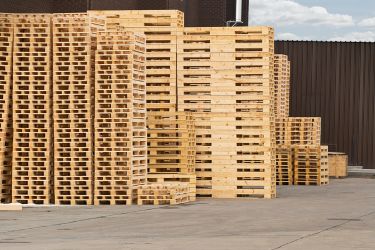
Pallet manufacturers face numerous cost pressures, which can vary significantly depending on prevailing market and economic conditions. Raw materials costs can vary considerably over time, as can their mere availability. Demand for your pallets can also fluctuate according to factors completely outside your control. Whether these factors involve increased competition from other pallet manufacturers, challenges affecting the markets your company serves, or overall prevailing economic conditions, you need to be prepared to navigate the inevitable uncertainties your business will face in a way that sustains your business throughout any circumstances.
That’s why, to sustain your pallet manufacturing business over the long term, you need to put multiple strategies for pallet manufacturers facing cost pressures in place. Best practices in pallet management aren’t only beneficial for your customers; they’re also beneficial for you.
Good pallet cost management benefits pallet manufacturers in many ways including:

Companies using pallets for their businesses have gotten increasingly savvy about shopping around for pallets which means you need to be savvier about how to encourage potential customers to choose your company over a competing pallet manufacturer. This alone can place additional cost pressures on your business.
Effective marketing is a pivotal way to ensure that both your potential and existing customers understand why choosing your business benefits them more than opting for one of your competitors. Having better products and services to market in the first place, of course, is paramount.
By adopting some of the following strategies for pallet manufacturers facing cost pressures, you can mitigate the ever-changing cost pressures you’ll invariably face and keep business flowing during those more challenging periods.
A careful, ongoing consideration of the factors affecting the materials you choose for making your pallets can help you adapt to changing economic climates in a way that allows you to continue serving your customers’ needs while protecting your top line.
For example, your customers are undoubtedly researching ways to alleviate their own cost pressures. In the process, they are learning the economic value to them of sourcing wooden pallets over plastic ones. These bear more weight than their plastic counterparts and are around three times cheaper. Being thicker than plastic pallets, wooden pallets are less likely to shift during transit. They’re also simpler to repair. It’s therefore wise, if not imperative, to offer a sufficient stock and variety of wooden pallets to those customers facing their own budgetary constraints.
Likewise, you want to be able to offer customers with the ability to pay for quality a more durable, lightweight, long-lasting and easier-to-maintain option. Plastic pallets check all these boxes. If you’re courting customers in the food and beverage, chemical or pharmaceutical sectors, offering plastic pallets is essential. Their increased longevity, better performance under varying weather conditions, and ability to protect fragile loads make the demand for these pallets likely to continue rising over the coming years.
Poise yourself to serve both the budgetarily restricted and quality-focused subsets of your customer base by offering both wooden and plastic pallets. By manufacturing both types of pallets, you can also better navigate changes in raw materials costs. Adjust your output to current supply and demand conditions.

Businesses using pallets are increasingly advised to consider using refurbished pallets as a way to reduce their own costs and navigate pallet procurement cost pressures. Therefore, one potential strategy for pallet manufacturers facing cost pressures is to offer refurbished pallets to these customers.
Refurbishing pallets saves you on raw materials costs by allowing you to repurpose materials already in use. Instead of enduring the costs of purchasing raw materials to constantly replace worn or defective pallets with fresh, new ones, you can maximize the value you get from materials you’ve already purchased.
With the proper marketing, you can educate customers about the sturdiness and dependability of refurbished pallets and give them an alternative option to purchasing more expensive new pallets during their own leaner times.
One way to maintain a steady income flow in the face of pallet production constraints is to expand your service offerings. One such service is pallet removal and disposal. Many customers would be delighted to have a single company handle both their procurement and disposal needs. You could even offer a bundled pricing model for customers interested in using your company for both services. You might even be able to use some of the material you remove in your pallet refurbishment efforts.

Another service you can offer to compensate for reduced production or demand capacities is to provide your customers with a way to maximize their use of the pallets they've already procured from you. You can do this by offering to repair damaged pallets and return them to their original condition. This, too, widens your pool of potential business by giving customers who are unable to afford new pallets a way to keep their own supply chain moving despite current budgetary constraints.
For instance, if all that a pallet needs to go from being unusable to being usable again is a replaced runner or a fixed split deck, you can provide that service with minimal cost to you and make a little more money from pallets you’ve already manufactured and sold or rented. By helping your customers reduce waste, you save them money while providing yourself with an additional stream of income that doesn’t entail the costs associated with procuring raw materials and manufacturing new pallets.
Delivering full truckloads of pallets is the most economical option for you and your customer. But sometimes conditions don’t allow for customers to purchase full truckloads at one time. One way to serve these customers’ needs is to offer partial truckload deliveries for a slight premium.
This helps keep your inventory moving while allowing you to earn a little more money from each pallet produced. Just ensure that you account for the increased delivery costs per trip in your pricing model for these services.
Meanwhile, you can maximize your delivery costs by combining multiple partial truckload orders into a single truck and mapping out your route to deliver to multiple customers in a single round trip. If each customer is paying a delivery fee and/or a premium cost for pallets when ordering a partial truckload, yet you’re still making full truckload deliveries to multiple customers, you can pocket most of that extra income as profit.
Similarly, pallet manufacturers facing cost pressures can consider offering pallet pooling to their customers. Pallet pooling allows customers to rent your pallets instead of purchasing them outright. This widens the pool of potential customers you can serve by making your pallets available to those on a tighter budget themselves.
Ultimately, this allows you to generate more revenue over the long term from the same supply of pallets by recirculating them from one customer to another. All you need to do is arrange to retrieve pallets after their rental period expires, inspect them, repair them if necessary and deliver them to the next customer. Pallet pooling is therefore one significant tactic for helping you to manage the cost and raw material challenges facing pallet manufacturers today.
Helping your customers decide which option is best for them —owning or renting pallets —allows you to provide more value to your customers, which can in turn help with customer retention and satisfaction. You’ll spend less time and fewer resources on procuring customers and more time on maximizing your income from your existing customers and the pallets you can produce with your restricted budget.

Adequate lead times are essential for companies who rely on pallets for their business to control costs, but sometimes circumstances don’t allow for optimal lead times. This is where you can come in and save the day. By offering rush services for a premium of course, you can serve these customers in their times of need while putting additional money in your coffers for the same inventory of pallets. Customers in emergencies may be willing to pay up to 20 percent more for rush pallet procurement and may well be accustomed to bearing such additional expenses.
By improving your systems for tracking and storing inventory, you can increase pallet longevity, reduce unnecessary production and expedite handling and transit times. Many automated systems now exist to help simplify this process and integrate seamlessly with your existing workflow, without requiring additional staffing hours to achieve these ends. This includes both hardware and software solutions, ranging from employing automated, robotic pallet runners in your warehouse to integrating RFID technology into your tracking systems and leveraging a TMS (transportation management system) for your shipments.
Making your manufacturing systems more sustainable serves you in at least two ways. It reduces your long-term expenditures, and it enables you to appeal to customers who prioritize sustainability factors in their purchasing decisions. For example, by optimizing configurations, you can minimize shipments, packaging waste and carbon emissions alike.

When circumstances require you to limit your production capabilities, it can be helpful to determine exactly what your customers need and the factors they’re currently prioritizing. A simple customer survey is easy to draft and circulate; most customers will be delighted to provide input on what considerations matter to them the most. Alternatively, review recent orders and analyze the types and qualities of pallets customers prefer.
For example, rather than creating a full stock of Grade A and Grade B pallets, you can inquire of your customers which ones they prefer. If all your customers are leaning toward Grade B pallets due to their own cost considerations, then you may not need to expend as many resources on producing all those Grade A pallets. Likewise, if most of your customers are ordering 48-inch pallets, you may not need such a steady flow of 42-inch pallets in your production line.
In addition to product specifications, you can also survey your customers about their service needs, such as pallet waste retrieval, repair services or shorter lead times.
Especially when facing cost and materials challenges, tailor your production to your actual customers actual needs rather than trying to provide all potential options to all potential customers. Then, when conditions allow, you can consider expanding your product and service offerings and using a pallet business marketing agency to help you access and appeal to a new base of customers seeking those alternatives.
By the same token, you can offer to help your customers to tailor their own procurement efforts to balance their needs with their budgetary restrictions best. Helping your customers optimize their purchasing decisions can, in turn, help you maximize your own production priorities and workflow.
Be it a national pallet network or a more localized one, by cooperating with other pallet manufacturers in serving customers’ ever-changing needs across a broader geographical and industry spectrum, you can appeal to a wider pool of prospective customers while helping to ensure that your existing customers get their needs met even when you’re unable to do so yourself directly.
There are numerous benefits for customers who use a pallet network to procure the pallets they need, including simplicity, consistency, and scalability. You can harness that value for your own benefit by making your company one of those that help to fulfill that promise.
In conclusion, whether you find ways to reduce your raw materials costs for the pallets you produce or ways to compensate for the expense you do bear for those materials, by implementing an array of strategies for pallet manufacturers facing cost pressures, you can optimize your current budget and keep your cash flow going and growing no matter the prevailing market and economic conditions.
For help presenting these alternative product and service options to customers in a way that helps them to see the value in these offerings, one final piece of financial wisdom is to hire a qualified and experienced pallet business marketing agency. Contact us today for more information about how our pallet marketing services can help you to weather ever-changing conditions affecting your pallet manufacturing business.